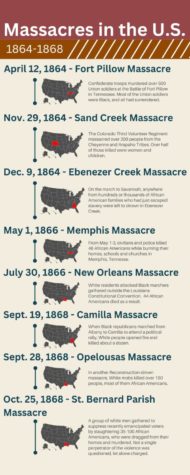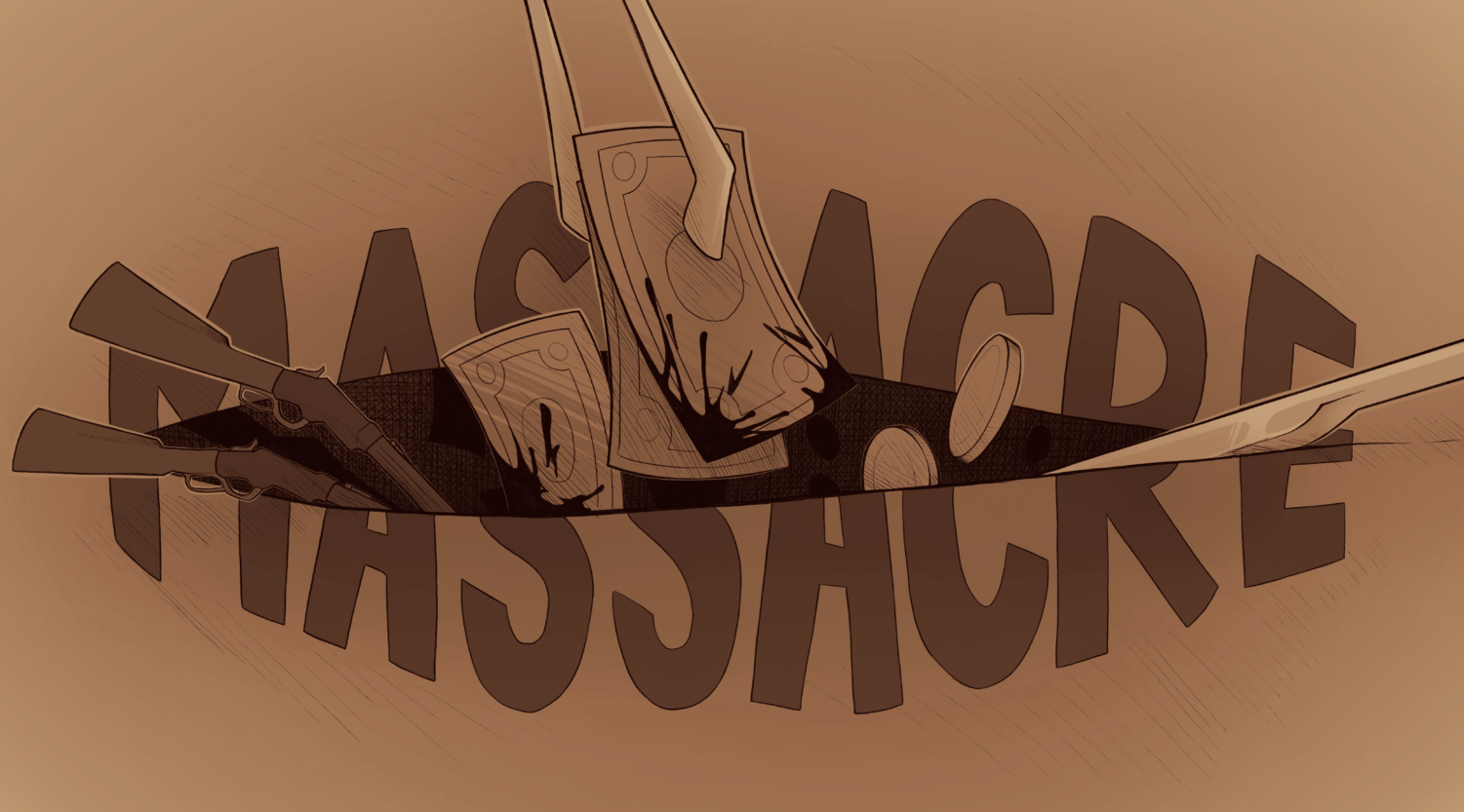Your donation will support the student journalists of the Evanstonian. We are planning a big trip to the Journalism Educators Association conference in Philadelphia in November 2023, and any support will go towards making that trip a reality. Contributions will appear as a charge from SNOSite. Donations are NOT tax-deductible.
Mass killings in America reveal pattern
February 27, 2023
The Sand Creek Massacre is not uncommon history—it’s emblematic of the United States functioning as it was structurally designed to. When the Founding Fathers wrote the Constitution, they neglected people of color, leading to centuries of oppression, bigotry and persecution. The country’s continuous struggle for political and social egalitarianism results in racial violence often going unnoticed. There have been 121 massacres against Indigenous people in the United States since 1830. For Northwestern Professor of Law and member of the NU John Evans Study Committee Andrew Koppelman, the act of naming this violence will help mend the unjust foundation upon which this country was built.
“I think that it’s important for us to understand the past, because it explains why the world we are in is what it is,” says Koppelman.
A key component of understanding the past begins with thorough dissection. Although no two massacres are identical, oftentimes history overlaps in an algorithmic manner, and identifying the elements that comprise such atrocities can help to recognize the deeper issues at hand.
The Foundation
A massacre begins with conflict between two groups, oftentimes over a struggle for land, power or money, and an attempt to mend such conflict frequently produces treaties.
“Treaties, in many ways, were valuable and useful for Indians as well as White people because they established borders [and] rules. Treaties, being ratified by the Senate and signed by the President of the United States should have some weight: with also heavy discussion,” shares Frederick Hoxie, a professor of history and American Indian studies at the University of Illinois Urbana-Champaign.
Although treaties serve to be a tool for peace, they frequently evolve into the antithesis of eased tensions. Treaties are rooted in compromise, which almost always leaves dissatisfaction within an individual or party. Time after time, broken treaties have established rising tensions in a region and diminish trust. In the case of Sand Creek, the Cheyenne and Arapaho tribes were angry that their leaders had agreed to a land treaty with the settlers. The settlers then broke this treaty, and Chivington’s troops ignored the white flag the tribes were told to raise to signify peace. At a surface level, treaties appear to be an ultimate resolution, but as history has shown, they rarely have that effect.
Long before the events at Sand Creek, treaties had revealed their tendency to initiate conflict. King Philip’s War, also known as the First Indian War, took place from 1675 to 1676 and is recognized as one of the last efforts the Wampanoag people made to keep their land from white colonists in New England.
I think that it’s important for us to understand the past, because it explains why the world we are in is what it is.
— Northwestern Law Professor Andrew Koppelman
Despite a negotiated peace treaty by Wampanoag chief Metacom, who later became known as King Philip, the English colonist’s attempts to encroach Native lands continued. Philip led an attack on an English settlement resulting in several Wampanoag people to be hanged. The war was incited against Philip’s confederacy by forming colonies, named the New England Confederation. The battle ended with the death of King Philip, who was killed by a member of the Wampanoag tribe, John Alderman. Philip’s head was placed on a spike for two decades at Plymouth colony. King Philip’s War is deemed the bloodiest war per capita in the United States and forced the Wampanoag tribe and countless other Native Americans to be sold into slavery or indentured servitude. This war inevitably set the scene for many future events and led to the progression of Native American slavery.
In an article written by Lindred D. Fisher, a history professor at Brown University, “between 1492 and 1880, 2 to 5.5 million Native Americans were enslaved in the Americas.” Slavery for Natives existed as early as 1636, but the finality of King Philip’s War opened the door for enslavement in large numbers and the dehumanization of Native lives.
But history has shown that the moving elements that bring massacres into execution extend far beyond just conflict and treaties. At the foundation, these two pieces provide a climate for bigotry to emerge and have influence. Conflict establishes an increased state of tension, and bigotry feeds off of the vulnerability.
Racial Violence
In early American history, perpetrators of Indigenous violence wanted their land, and they were able to justify their violence by establishing a rhetoric that dehumanized Indigenous people. The atrocities committed against Indigenous people happened because the perpetrators didn’t view them as humans.
“Part of the mindset of the troops was devaluing the lives of Native Americans,” Koppelman explains. “[It] seems pretty clear that quite a lot of what was done here would not have been done to white people, that they would have been unwilling to engage in this level of killing of white victims.”
Violence on the basis of race has repeatedly happened throughout American history because racism is embedded into the fabric of the United States. From the first injustice against Native Americans to modern day, these factors of a massacre have sparked suffering throughout history that continue to affect Indigenous groups. Massacres are not defined by the murderous rampages of a single instance, but the massacre of culture and freedom that Native Americans had cultivated for centuries prior.
Native Americans were not the only group impacted by this bigoted dehumanization. Just a few weeks after the Sand Creek massacre, the blood of hundreds of African-Americans were on the hands of members of Sherman’s Army, commanded by General Sherman who served for the Union Army in the Civil War. Sherman ordered his soldiers to refuse to assist families escaping from slavery across Ebenezer Creek, leaving them to drown.
This massacre further proves that when it comes to power, positions of authority are more inclined to condone cruelty by neglecting to acknowledge humanity in groups that differ from them. Sherman didn’t consider the lives of the people he killed to be worthy, because they obstructed the potential for wealth within the broader economic system that enslavement founded and sustained. As history has shown, humanity within the supremacist’s eyes is conditional, only granted to those with the power to supply it.
Attacks on the basis of race did not stop, and they haven’t stopped. Eighteen months following Sand Creek, 46 African Americans were murdered, along with plenty more injured in the acts of burning schools and churches in an event known as the Memphis Massacre. This three day act of racial violence was fueled from anger around the abolition of slavery and animosity over the liberated status recently given to African Americans.
Although Native Americans and African Americans had varying experiences in American history, the violence that occurred against these communities were not always separate.

The attack at the Apalachicola River was a direct form of mistreatment based on race to the groups of Native Americans and African Americans residing there. A report from the National Park Service explains, “Located in northwest Florida’s Franklin County, approximately 15 miles from the mouth of the Apalachicola River, British Fort is a symbol of the strong relationship between runaway slaves and the Seminole Indians.”
The Seminole tribe provided shelter and safety to African slaves who had run away from the states just north of Florida, and the formerly enslaved people would assist the Seminoles with farm work and other chores within the village.
White men in power at the time had already established a fear factor within white Americans regarding different racial groups, but adding to this threat was the potential for oppressed groups to gain power by working in alliance. Massacres begin when the perpetrator feels at a loss for control. Conflict establishes motivation, bigotry fuels influence and threats initiate action. Seminole people and African Americans pairing up was a threat to the authority of white people, and therefore, they resorted to violence.
In July of 1816, General Major Andrew Jackson commanded his troops to attack the Native people and African Americans at the Apalachicola River, and as a result, his soldiers killed about 300 people.
These events are certainly not abnormal when compared to what happened in 1864 in Colorado. Throughout the 1800s, there were waves of massacres against minority groups that all revolved around a central theme: a white man’s craving for power. Above all other tensions and components, every massacre has a leader, and every leader craves power in some facet. In the case of Sand Creek, the militia was ordered to attack by Colonel John Chivington. Chivington was an ordained minister before he became a major in the First Colorado Infantry. He’d had success previously in Civil War battles and felt that he had a reputation to uphold. He also wanted to ascend the ranks in his military division, and in order to do so, he needed to pull off something that he considered to be great. His hunger for power led to his violent attack.
But leaders rarely work alone, and a drive for power is never enough.
The Leader
When these horrific massacres of Indigenous people occurred, their leaders represented something bigger than themselves: hatred, racism and bigotry. A leader that serves as a symbol for a larger group of people is vital to the making of a massacre, because it allows for room to manipulate the public, and it is one of the reasons that Evans’ legacy persisted for decades.
Massacres have varying consequences for these blood-thirsty leaders, but generally speaking, few consequences are given to white colonists. In contrast, the aftermath for the victims is gruesome; the loss of land, the infliction of disease and visceral greed slaughtered countless Native Americans, but retellings of these stories often implicate the damage was not that impactful. Scholars have argued that the failure of the American education system to mandate correct and culturally sensitive education on Indigenous history and massacres is preventing generations of Indigenous people from getting the recognition they deserve. The history of Native American slavery in this country and the devastating loss to Native American culture has been overlooked for centuries.
“In general, the Native American history has been missing from the curriculum and it is important that there be more,” Carl Smith, Northwestern Professor of English, American Studies, and History reminds us.
The lack of education on Indigenous massacres and history has perpetuated the legacy of racists and murderers. John Evans allowed the atrocities committed at Sand Creek to occur under his watch, yet after the massacre, he was revered. For years after it occurred, the Sand Creek Massacre was labeled a “battle” and completely overlooked, and today, Northwestern still honors his legacy by maintaining the John Evans Alumni Center. In Sand Creek’s case, the aftermath of the massacre was one of dishonesty and masking.
Despite the Sand Creek Massacre’s high casualty toll, it was cast in the shadow of the Civil War. While many Colorado locals were privy to what happened at Sand Creek, the rest of the world was preoccupied. In fact, for a few years after the massacre, the Civil War was used to cover up the true nature of the killings.
“It was listed as a Civil War battle, and when the troops came back to Denver…they talked about all their bravery,” Smith explains.
In fact, for many years after the massacre, there was a sign posted at Sand Creek labeled “Sand Creek Battleground.” This misrepresentation of the massacre prevented it from getting properly recognized. This meant that white people in power were able to retain their positions and ignore their past faults, at the expense of generations of Indigenous people. Northwestern is a prime example of this. The university didn’t publish anything formally acknowledging its founder’s history until May of 2014. Until then, John Evans’ name was on scholarships, buildings and plenty of other university-related establishments.
Predictably, idolizing the perpetrators behind massacres was far from unique in the case of Sand Creek. In the Dakota Massacre of 1862, Henry H. Sibley led the killing, and he was demonized in the press for not being fast enough to attack. The portrayal of massacre leaders throughout the history of the United States as heroes executing an inherently good task that aligns with patriotic ideals greatly contributed to the lack of recognition of the horrors that occurred. However, this pattern of behavior has grown outdated over time.
“Today, when [a massacre] happen in the United States, it is generally perpetrated by some individual or a pair of mass shooters, so it is done by marginal characters who don’t represent anybody but themselves. This is progress … it is progress that these people do not present themselves, and are not authorized, to represent us all,” Koppelman says.
Modern day massacres, which often take the form of mass shootings, are most often carried out by individuals with biases or other mental illnesses contributing to their actions. They are never portrayed in mass media as valiant heroes, but the coverage they receive surrounding their actions still allows for their beliefs to obtain a platform, which gets to the root of a massacre: the lasting effect.
The Aftermath
When analyzing a massacre of this scale, it is critical to look at not just what happened back in the 19th century, but how its impacts have affected the modern generations of Cheyenne and Arapaho people. In every massacre, the lives lost signify a greater loss to an entire community of people. To this day, descendants of those alive at the time of the massacre are trying to heal from the social, emotional and spiritual damage that Sand Creek caused.
In general, the Native American history has been missing from the curriculum, and it is important that there be more.
— Northwestern Professor of English, American Studies and History Carl Smith*
“If you’re Cheyenne or you’re Arapaho, you need to go to [Sand Creek] and you need to do some healing, because I feel like people don’t realize that we carry this tragedy within us,” Vanessa Braided Hair, a Northern Cheyenne Sand Creek Massacre descendant, explains in a PBS documentary about the massacre.
Sand Creek is now marked as the site of a historic massacre, where Cheyenne and Arapaho descendents often go to experience healing. This loss sustained when this massacre happened is still being felt. What happens in almost every massacre is the creation of generational trauma, and that fact must always be kept in mind when dissecting these horrific events.
It’s important to consider the sociological aspects of massacres as well as the physical and psychological ones. This mixture of factors can show us not only what sparks a massacre, but why massacres truly occur and how deeply they affect those victimized. The acts that have happened in our past are things that can not be forgotten. The combination of escalated conflicts, racism, a hunger for power and a lack of accountability leave us with these tragic events scattered all too often throughout history. The massacres that occurred throughout the history of the United States and the effects that they had, and continue to have, on society are abundant. These effects must be acknowledged so that the true nature of America’s unheroic and unjust past isn’t hidden, and those who’ve felt the greatest impact of these massacres have the opportunity to heal.
*Correction: The print version of this issue incorrectly attributes this Carl Smith pull quote to Andrew Koppelman. The Evanstonian apologizes for this inconvenience and will do everything in its power to stop it from recurring.

